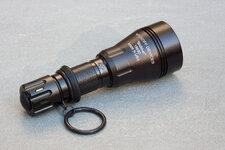IMA SOL MAN
Flashlight Enthusiast
But can it take the heat?
 Help Support Candle Power Flashlight Forum
Help Support Candle Power Flashlight Forum
But can it take the heat?
But can it take the heat?
This is the material Malkoff uses for the diffusion lenses (or something very similar to it);
 www.candlepowerforums.com
www.candlepowerforums.com

Yet, many flashlights can benefit from the use of a light-shaping diffuser lens to smooth the beam and remove rings, artifacts, etc. with minimal loss of output.

 budgetlightforum.com
budgetlightforum.com

 budgetlightforum.com
budgetlightforum.com
I don't know how the measurements were made, but only a 3.2% reported loss of light (inferred VLT of 96.8%) for a diffusion film seems a bit optimistic.Thread on Duffusion film sales. DC-Fix tested by Selfbuilt at only 3.2% loss of light... The Ace Hardware film in previous thread posted was even less loss of light than DC-Fix...

DC-Fix Diffusion Film Sale
* Updated 11-01-22 Two - 3 " x 6" sheets of the "Famous Dc-Fix" only $3.50 Add $1.50 for extra sheets $1 - US shipping +$ 2 - international shipping Dc-fix will take a really bad beam and turn it into soft buttery smooth delight with amazingly low light loss (3.2% ) I've...budgetlightforum.com
Luminit (5 degree) is hard to find. You have a retailer source? I believe Luminit will do samples at $30 shipping if you have a shipper account... I'd get the 5 degree if I could find a source...
FWIW, the Luminit sheet can be reasonably cut on a laser cutter, with only minor browning of the cut lines.Purchasing the 0.01" polycarbonate 5-degree sheet material from Luminit and the tooling to professionally cut* round flashlight lenses is something I have in the works. The goal is to offer cut-to-order diffusion lenses up to about 55 mm in diameter, and pre-cut lenses to fit a variety of Malkoff heads including the MDX 22.3, E-series, VME, Wildcat, Hound Dog and Hound Dog Super.
*the material can be cut with scissors, but for us perfectionists the results of trying to cut a perfectly round disc with a smooth edge is what you'd expect.
I don't know how the measurements were made, but only a 3.2% reported loss of light (inferred VLT of 96.8%) for a diffusion film seems a bit optimistic.
Purchasing the 0.01" polycarbonate 5-degree sheet material from Luminit and the tooling to professionally cut* round flashlight lenses is something I have in the works. The goal is to offer cut-to-order diffusion lenses up to about 55 mm in diameter, and pre-cut lenses to fit a variety of Malkoff heads including the MDX 22.3, E-series, VME, Wildcat, Hound Dog and Hound Dog Super.
*the material can be cut with scissors, but for us perfectionists the results of trying to cut a perfectly round disc with a smooth edge is what you'd expect.
I should have the material in about a week, I'll keep you posted!I'd be interested in getting some 5 degree from you as I have a spare Hound Dog lens landing today that I was going to use as a diffuser since my HD didn't come with one...
My hound dog super is awesome all by itself. You gotta be a bit weak in the nuts to be asking for a better light. Mine had a nice scratch in the reflector (is it a reflector?) And I still love it like a new puppy.$24 bucks eh? Yeah..., no thanks man.
$24 bucks eh? Yeah..., no thanks man.
You didn't even offer convincing beam shots. (Yes I went to your website)
Lots of other options man.
You didn't offend me man.FYI
Malkoff sells the 43 mm replacement diffuser for the standard HD and WC for $10 plus $10 priority mail shipping ($20 total vs. $24 total for the 53 mm to fit the HD Super).
Sorry I offended you by responding to your inquiry.